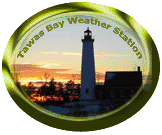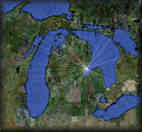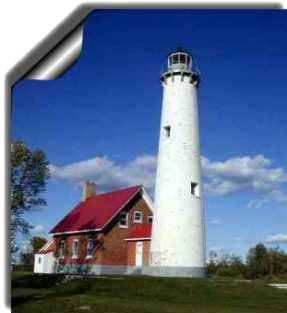 Ottawa
Point (officially changed to Tawas Point in 1902) presents a hazard to
navigation as it juts out into Lake Huron. It also shelters Tawas Bay,
protecting ships from strong north or northeast winds. In 1850, the
Federal government set aside $5,000 to build a lighthouse near the end
of Ottawa Point (about where the state park's contact station is
located).
Ottawa
Point (officially changed to Tawas Point in 1902) presents a hazard to
navigation as it juts out into Lake Huron. It also shelters Tawas Bay,
protecting ships from strong north or northeast winds. In 1850, the
Federal government set aside $5,000 to build a lighthouse near the end
of Ottawa Point (about where the state park's contact station is
located).
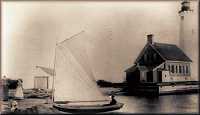 The
Lighthouse Service paid Daniel S. Ellethorpe $200 for the 30 acre
property. The first light was fueled by lard oil. This was changed to
kerosene, most likely in 1898, when the oil house was built. Because
kerosene was quite volatile, it had to be stored in a separate,
well-ventilated structure. The lard oil would have been stored in the
cellar of the keeper's quarters.
The
Lighthouse Service paid Daniel S. Ellethorpe $200 for the 30 acre
property. The first light was fueled by lard oil. This was changed to
kerosene, most likely in 1898, when the oil house was built. Because
kerosene was quite volatile, it had to be stored in a separate,
well-ventilated structure. The lard oil would have been stored in the
cellar of the keeper's quarters.
The lighthouse was the first permanent structure in the area. Construction was begun in 1852 and completed in 1853. The lighthouse marked the location of the point so mariners could either avoid it or seek refuge behind the point in Ottawas Bay in a storm. In 1854, the first European settlers arrived in the area. The name of Ottawas Bay was shortened to Tawas Bay and the City of Tawas City was platted there in 1855.
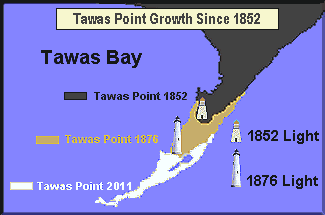 Between
the building of the first lighthouse in 1853 and the early 1870's, due to the
natural accretion of sand, Tawas Point had been steadily extending itself out
into what had once been open water. By 1870 the original lighthouse (which was a
short tower with a wide base) was of little realistic use for mariners.
Construction on the new lighthouse began on August 12, 1876 and finished by the
end of the shipping season of that year. This new lighthouse cost the U.S.
government $30,000 (purchasing of land included). When the new lighthouse was
constructed, it was located at the very end of what was beginning to be known as
Tawas Point. As Tawas Point grew, a large dock was built to reach the deep water
of Tawas Harbor, where boats known as lighthouse tenders could tie up and unload
supplies. Also added through the years were an oil house, a boathouse, a fog
signal building, a storage building and an assistant keepers dwelling. Of these
buildings, only the oil house and storage building remain.
Between
the building of the first lighthouse in 1853 and the early 1870's, due to the
natural accretion of sand, Tawas Point had been steadily extending itself out
into what had once been open water. By 1870 the original lighthouse (which was a
short tower with a wide base) was of little realistic use for mariners.
Construction on the new lighthouse began on August 12, 1876 and finished by the
end of the shipping season of that year. This new lighthouse cost the U.S.
government $30,000 (purchasing of land included). When the new lighthouse was
constructed, it was located at the very end of what was beginning to be known as
Tawas Point. As Tawas Point grew, a large dock was built to reach the deep water
of Tawas Harbor, where boats known as lighthouse tenders could tie up and unload
supplies. Also added through the years were an oil house, a boathouse, a fog
signal building, a storage building and an assistant keepers dwelling. Of these
buildings, only the oil house and storage building remain.
The lens, which magnifies the light, is known as a fourth order Fresnel. This is named for Augistin Fresnel, the French Engineer who invented it. Fourth order refers to the size of the lens. There are seven sizes of fresnel lenses: First, second, third, three-and-a-half, fourth, fifth, and sixth. Sizes range from first being the largest to sixth being the smallest. Great Lakes lighthouses generally have lenses of third order and smaller. The original lens of the 1853 lighthouse (and moved to the 1876 lighthouse) was a fifth order fresnel. The current fourth order lens, which was constructed in Paris in 1880, was installed in 1892.
The tower of the Tawas Point Lighthouse is sixty-seven feet high, placed on a three-foot high base. This gives the light a seventy-foot high focal plane, which can be seen approximately sixteen miles out into Lake Huron. The tower slopes from a sixteen-foot diameter base to 9-1/2 feet diameter at the parapet of the lantern. The tower is made up of two brick and masonry walls. The outer wall is 22 inches thick and the inner wall is eight inches thick. Between the two walls is a two-foot wide air space, which acted as a chimney to bring air up to the lantern to fuel the lamp. The fourth order fresnel lens is still in use at the lighthouse. Since 1935, it has been powered by electricity. The light is rated at 200,000 candle power.
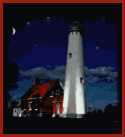 The
last full-time light house keeper left the lighthouse in 1946, but the keeper's
quarters were used into the 1990s as housing for the nearby Coast Guard station.
Current plans are to restore the keeper's quarters to reflect life at Tawas
Point from 1900 to 1946. Each room of the first floor will be restored to
reflect its appearance during a certain period. The interpretation of the Tawas
Point Lighthouse will focus on how the lighthouse keepers and their families
interacted with the local community and how the lighthouse played an important
role in the community. Historians are using a wide variety of research to make
sure that the restoration is accurate. By focusing on the Twentieth century, we
can utilize the reminiscences of people who once lived at the lighthouse as
children. These, along with diaries, journals, letters and photographs, will
help give an accurate picture of life on Tawas Point. Records of the U. S.
Lighthouse Service and the U.S. Coast Guard also allow the work at the
lighthouse and its appearance to be correct. Finally, local newspapers show us
what life in East Tawas and Tawas City was like at the time. The 2 story house
that was adjacent to the lighthouse (shown in the first photo below) has been
removed. The lighthouse and the keeper's house are now illuminated at night by
an exterior lighting system.
The
last full-time light house keeper left the lighthouse in 1946, but the keeper's
quarters were used into the 1990s as housing for the nearby Coast Guard station.
Current plans are to restore the keeper's quarters to reflect life at Tawas
Point from 1900 to 1946. Each room of the first floor will be restored to
reflect its appearance during a certain period. The interpretation of the Tawas
Point Lighthouse will focus on how the lighthouse keepers and their families
interacted with the local community and how the lighthouse played an important
role in the community. Historians are using a wide variety of research to make
sure that the restoration is accurate. By focusing on the Twentieth century, we
can utilize the reminiscences of people who once lived at the lighthouse as
children. These, along with diaries, journals, letters and photographs, will
help give an accurate picture of life on Tawas Point. Records of the U. S.
Lighthouse Service and the U.S. Coast Guard also allow the work at the
lighthouse and its appearance to be correct. Finally, local newspapers show us
what life in East Tawas and Tawas City was like at the time. The 2 story house
that was adjacent to the lighthouse (shown in the first photo below) has been
removed. The lighthouse and the keeper's house are now illuminated at night by
an exterior lighting system.
Because of its location, the lighthouse became a part of Tawas Point State Park and the Department of Natural Resources is the sole department responsible for the site. The Parks and Recreation Division and the Michigan History Center oversee the site. With the assistance of the non-profit Friends of Tawas Point State Park, lighthouse tours are conducted during most weekends from Memorial Day to Labor Day and also at other dates throughout the year. Admission fees for the lighthouse tours are going directly into an account for the restoration of the lighthouse and keeper's quarters. If you are interested in helping to restore the lighthouse, the easiest way is to join the Friends of Tawas Point State Park. Besides volunteering to give lighthouse tours, the Friends help out in a number of other ways. For more information, please call Tawas Point State Park at (989) 362-5041 or visit the DNR website for the Tawas Point Lighthouse.
The light on the lighthouse has now been de-commissioned by the U.S. Coastguard.
An excellent description of the history of the
Tawas Point Lighthouse is also available on the
 "Seeing
the Light" website by clicking
"Seeing
the Light" website by clicking
 here.
Books and DVD's about the history of the Tawas Area and the Northeast
Shore by historian Neil Thornton can be purchased at the
Booknook bookstore in East Tawas.
here.
Books and DVD's about the history of the Tawas Area and the Northeast
Shore by historian Neil Thornton can be purchased at the
Booknook bookstore in East Tawas.
